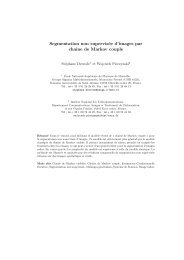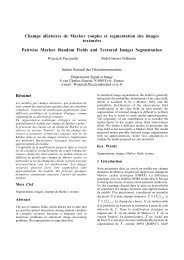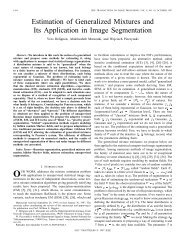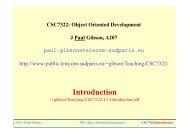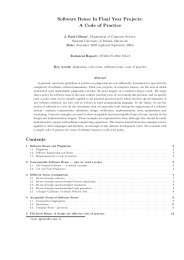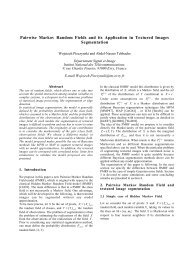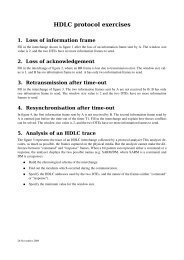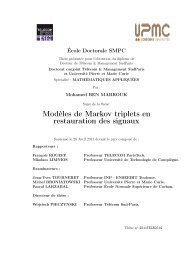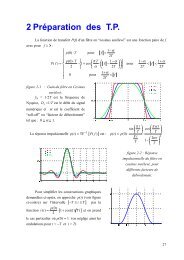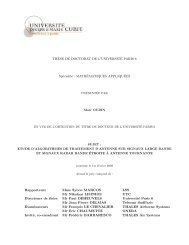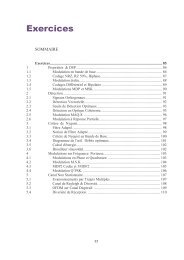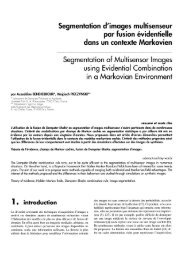Multisensor triplet Markov fields and theory of evidence
Multisensor triplet Markov fields and theory of evidence
Multisensor triplet Markov fields and theory of evidence
Create successful ePaper yourself
Turn your PDF publications into a flip-book with our unique Google optimized e-Paper software.
As a consequence, different Bayesian segmentation techniques<br />
can be implemented.<br />
Let us notice that an HEMF is also a PEMF, <strong>and</strong> thus when<br />
considering an HEMF we have the choice between two<br />
different ways <strong>of</strong> using some ‘prior’ information modeled by a<br />
classical probabilistic <strong>Markov</strong> field.<br />
4.2. The case <strong>of</strong> numerous sensors<br />
Let us consider r sensors: Y s ZðYs 1 ; .Ys r Þ. We take rZ2 for<br />
the sake <strong>of</strong> simplicity (the extension to rO2 is immediate, see<br />
also the next section). So, we have Y s ZðYs 1 ; Ys 2 Þ <strong>and</strong> y s Z<br />
ðy 1 s ; y 2 s Þ denote its realization. We will assume that the sensors<br />
are independent, which means that in the classical case that we<br />
are going to generalize, the r<strong>and</strong>om <strong>fields</strong> Y 1 , Y 2 are<br />
independent conditionally on X.<br />
As above, let us consider the same UZ{u 1 ,.,u k }, LZ<br />
P(U), <strong>and</strong> L 1 3L, L 2 3L such that each Ys<br />
1 is sensitive to<br />
the elements <strong>of</strong> L 1 <strong>and</strong> each Ys<br />
2 is sensitive to the elements<br />
<strong>of</strong> L 2 . Furthermore, let L 1,2 3L be the set <strong>of</strong> sets A3L<br />
such that there exists A 1 3L 1 <strong>and</strong> A 2 3L 2 verifying<br />
AZA 1 hA 2 .<br />
As in the previous subsection, let us first recall the<br />
extension <strong>of</strong> the classical bi-sensor HMF-IN proposed in [3].<br />
The first sensor produces q y1 ; ðx * Þf Q s2S pðy 1 s jx s * Þ, the<br />
second produces q ;*ðx y2 * Þf Q s2S pðy 2 s jx s * Þ, <strong>and</strong> the information<br />
provided by the observation (Y 1 ,Y 2 )Z(y 1 ,y 2 ) is given<br />
on (L 1,2 ) n by<br />
q ðy1 ;y 2Þ; ðx * Þ Z ðq y1 ; 4q y2 ; Þðx * Þ<br />
2<br />
3<br />
f Y X<br />
4<br />
s2S<br />
pðy 1 s jx * ;1<br />
s Þpðy 2 s jx * ;2<br />
s Þ5 (4.5)<br />
x * ;1<br />
s hx * ;2<br />
s Zx s<br />
*<br />
Then p(xjy) is given by a formula similar to (4.1), obtained<br />
by replacing pðy s jx s * Þ with P x * ;1<br />
s hx * ;2<br />
s Zx s * pðy1 s jx * ;1<br />
s Þpðy 2 s jx * ;2<br />
s Þ. We<br />
see that the sensors can be fused ‘pixel by pixel’, which is the<br />
reason why there is no need for <strong>triplet</strong> <strong>Markov</strong> <strong>fields</strong> when the<br />
extensions <strong>of</strong> HMF-IN are considered.<br />
Let us now consider the new case <strong>of</strong> spatially correlated<br />
sensors. As above, we have two cases: (X*,Y) is an HEMF<br />
with known <strong>Markov</strong>ian p(x*), or (X*,Y) is a PEMF with<br />
unknown p(x*). In the first case we apply (4.2) to each<br />
sensor to get q y1; *<br />
ðxÞ <strong>and</strong> q y2 ;*ðx * Þ, <strong>and</strong> we have the following<br />
proposition.<br />
Proposition 4.3. Let M 0 be the <strong>Markov</strong> field on U n defined by<br />
M 0 ðxÞZg exp K P <br />
c2C 4 c ðx c Þ , <strong>and</strong> let M 1 , M 2 be bba’s<br />
defined on (L 1 ) n <strong>and</strong> (L 2 ) n , for fixed y2R n , by q y1 ;*ðx * Þ <strong>and</strong><br />
q y2 ;*ðx * Þ. Let DZfðu; A 1 ; A 2 Þ2U!L 1 !L 2 ju2A 1 hA 2 g.<br />
Then the DS fusion (M 0 4M 1 4M 2 )(x) is the probability<br />
p(xjy) defined by the TMF TZ(X,X* ,1 ,X* ,2 ,Y) whose distribution<br />
on D n !R n is given by<br />
W. Pieczynski, D. Benboudjema / Image <strong>and</strong> Vision Computing 24 (2006) 61–69 67<br />
pðx; x * ;1 ; x * ;2 ; yÞfexp K X c2C<br />
4 c ðx c Þ<br />
K X c2C<br />
K X c2C<br />
"<br />
4 * ;1<br />
c ðx * ;1<br />
c<br />
4 * ;2<br />
c ðx * ;2<br />
c<br />
; y c Þ C X c2C<br />
; y c Þ C X c2C<br />
4 0 *;1<br />
c ðx * ;1<br />
c<br />
4 0 *;2<br />
c ðx * ;2<br />
c<br />
Þ<br />
Þ<br />
#<br />
(4.6)<br />
as a consequence, different Bayesian segmentation techniques<br />
can be implemented.<br />
The pro<strong>of</strong> is similar to the pro<strong>of</strong> <strong>of</strong> Proposition 4.1.<br />
This second case is quite similar to the second case <strong>of</strong> the<br />
previous subsection: we obtain a proposition analogous to<br />
Proposition 4.2 above, with the only difference that in p*(x*jy)<br />
we have yZ(y 1 ,y 2 ).<br />
5. General model<br />
We assumed in the previous sections that either the prior<br />
information, or the observation provided by sensors, were<br />
probabilistic <strong>and</strong> modeled by some <strong>Markov</strong> <strong>fields</strong>. This enabled<br />
us to see how different classical models can be successively<br />
extended to more <strong>and</strong> more complex—or simply different—<br />
situations. This section is devoted to an ultimate extension:<br />
Let us consider r sensors: YZ(Y 1 ,.,Y r ), <strong>and</strong> Y i ZðYsÞ i s2S for<br />
iZ1,.,r. Let M<br />
0 be a prior EMF defined on (L 0 ) n by<br />
M 0 ðx * ÞZg 0 exp K P <br />
c2C 4 0 cðx c * Þ , <strong>and</strong> for iZ1,.,r let M i be<br />
the EMF defined h on (L i ) n , for fixed y i , by a PEMF<br />
M i ðx *;i ÞZg i exp K P i<br />
c2C 4 i cðx * ;i<br />
c ; y i Þ . Let us consider L the<br />
set <strong>of</strong> all A3U such that there exists at least one (A 0 ,A 1 ,.,A r )<br />
2L 0 !L 1 !/!L r for which AZA 0 hA 1 h/hA r . Then the<br />
DS fusion gives MZM 0 4M 1 4/4M r defined on L n by<br />
Mðx * Þ<br />
f<br />
X<br />
"<br />
½x* Zx<br />
ðx *;0 ;x *;1 ;.;x Þ1 *;0 hx *;1 h.hx *;r Š exp K X 4 i cðx c<br />
*;0 ÞK X " ##<br />
X<br />
4 i cðx c *;i ;y i Þ<br />
*;r c2C<br />
1%i%r c2C<br />
(5.1)<br />
<strong>and</strong> thus, as in the particular cases above, M can be interpreted<br />
as a marginal distribution defined on L n <strong>of</strong> the EMF defined on<br />
ðDÞ n ZL n !ðL 0 Þ n !ðL 1 Þ n !/!ðL r Þ n by<br />
M 0 ðx * ;x *;0 ;x *;1 ;.;x *;r Þ<br />
"<br />
f1 ½x * Zx *;0 hx *;1 h/hx *;r Š exp K X 4 i cðx c<br />
*;0 ÞK X " ##<br />
X<br />
4 i cðx c *;i ;y i Þ<br />
c2C<br />
1%i%r c2C<br />
(5.2)<br />
Let us notice that, on the contrary <strong>of</strong> the two previous sections,<br />
the result M(x*) is not necessarily a probability measure. However,<br />
it is still possible to perform statistical segmentation using the socalled<br />
‘maximum <strong>of</strong> plausibility’ principle. More precisely, once<br />
Mðx s * Þ is estimated, we compute the plausibility <strong>of</strong> each x s Zu2U<br />
by Plðx s ZuÞZ P u2x s * Mðx* s Þ, <strong>and</strong> then the estimated ^xZð^x s Þ s2S is<br />
given by ^x s Zarg max u Plðx s ZuÞ.<br />
Example 5.1. Let us consider an example illustrating the<br />
interest <strong>of</strong> the general model (5.2) <strong>and</strong> its use in a concrete



